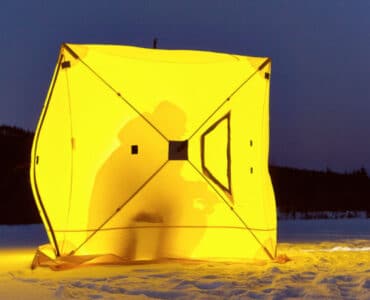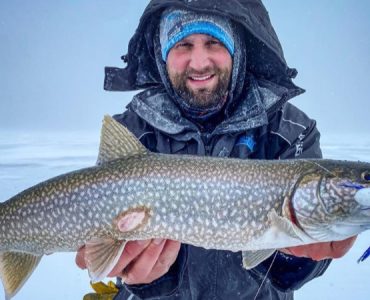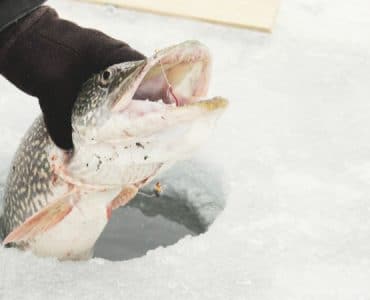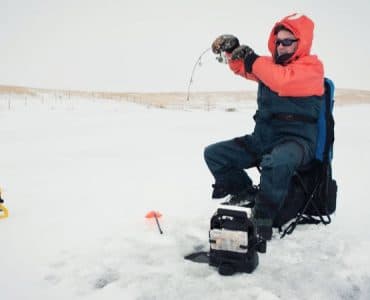The idea of fishing in sub-freezing temperatures keeps weaker minded people indoors. When you have the proper clothing, gear, and shelter the wind and cold are manageable, if not even enjoyable. Here is a complete ice fishing gear list so you won’t forget anything as you get ready for the winter fishing season.
[toc]Rods and Reels
- Spinning Reels – Ice spinning reels are just smaller versions of the open water spinning reels most anglers know and love. An ice reel is frequently just the smallest sized reel in a series, like a 500 or 1000 size reel. They are designed to handle very light line and work together with the short ice rods.
- In-Line Reels – This type of reel has been around for a long time, eventually forgotten once small spinning reels became popular. They have increased in popularity in recent years, thanks to updated designs and the fact that they can handle light line well without the line twist you see with spinning gear.
- Combos – Combos are simply a rod and reel sold together as a set. They are cheap and convenient to buy, but you can usually get a better setup buying the rod and reel separately. The best ice combos are great for the casual or beginner ice angler.
- Tip-Ups – Tip ups are set it and forget it rigs that allow anglers to put out multiple baits in an area to cover more water. They consist of a small plank that sits over the ice hole, and holds a spring-loaded flag. When a fish takes the bait and swims off, the line pulls and releases the flag to indicate the bait has been taken. I’m warning you now, fishing tip ups is a very fun way of ice fishing and tends to catch bigger fish.
- Ice Fishing Line – Depending on the species you are targeting, you might want to spool up with mono that has some stretch, or no stretch braid. Tip-ups usually use a dark colored heavier braid for targeting larger predator fish like pike, walleye, and lake trout.
Ice Fishing Clothing
- Boots – Insulated, waterproof boots are best for ice fishing. Keeping your feet warm is key to having an enjoyable trip. Nothing ruins an ice fishing trip faster than cold, wet feet!
- Gloves – Your hands are as important as your feet. Fingers need protection from frigid temperatures and wind. Ice fishing gloves are waterproof, and have flip open finger covers to make dealing with fishing line easier. Look for gloves that have wrist coverage and can slide up underneath your jacket sleeves.
- Base Layers – Base layers keep your bodies warmth close to the skin, helping you keep your body heat longer. Long underwear is the most basic base layer and works fine. There are tons of new advanced fabric base layers now that are lightweight and very thermally efficient.
- Outerwear – Even if you are fishing from a permanent ice shelter, proper pants and jackets are important. The best ice fishing jackets and pants are Insulated, windproof, and waterproof. Canvas pants and jackets like Carhartt are popular and affordable, but they aren’t waterproof.
- Headwear – At minimum, ice fishermen should wear a quality stocking hat. Even better are fur or fleece lined hats with ear flaps that help hold in more warmth. Balaclavas are even better, as they have complete face and neck coverage.
- Handwarmers – These little packs are cheap and easy to drop into boots and gloves for hours of extra warmth. They’ll never replace a good heater, but are good in a pinch.
- LED Headlamp – The sun goes down earlier in winter. To capitalize on the good evening bite, it’s likely you’ll fish into the dark hours. Besides a bright lantern, a solid LED headlamp helps light up your shelter, glow your jigs, and help you find the snowbank to relieve yourself on.
Ice Augers
- Hand Powered Augers – Drilling your holes by hand might seem like an old-fashioned way to cut holes in the ice, but it’s not. Hand augers are lighter and quieter, and have a side benefit of helping you warm up when you drill a few new holes. Keeping a sharp edge on the chisel tip will make quick work of even the thickest ice.
- Gas Powered Augers – Power augers simply add a gasoline engine to the top of the auger shaft to drive the shaft. New gas augers cost much more than a hand model, but the ability to drill multiple holes in seconds is a big advantage. Look for a good 4 stroke model so you won’t have to mix oil and gas. 4 strokes are also smoother and quieter running.
- Electric Augers – There are two styles of electric augers. The first is a hybrid design that allows you to attach a cordless drill to the shaft to drive the blades. These have become very popular, but work best with only the largest size drills. The other type is a true electric auger. These new augers take advantage of rechargeable lithium battery technology, which can provide a surprising amount of power. A light weight auger, running on clean power, with near silent operation is a fantastic combination.
Ice Shelters & Sleds
Shelter from the cold and wind ensures a safe, comfortable, and hopefully productive fishing trip, while also being a big part of overall ice fishing safety.
- Hub Shelters – Hub shelters are designed much like their hub ground blind cousins. They are designed with an internal frame that simply expands and locks into place creating the roof and walls of the shelter. Hub shelters are the most affordable, but not the easiest to move if you like to change fishing spots frequently. They also do not come with an ice sled to move your shelter and gear.
- Flip Up Shelters – Flip style shelters are the most expensive, but have multiple built in features that make them awesome for ice fishing. The shelter starts with a plastic sled base, sometimes with built in seats and compartments for your gear. The shelter itself is collapsed on top of the sled, creating a kick ass self-contained mobile fishing headquarters.
- Cabin Shelters – Cabin style shelters have a hard, plastic square floor with a couple flip up hole covers. They fit nicely into the back of a small truck or ice sled, and set up much like a camping tent. They provide a lot of space for the money, but like the hub shelter, they are very mobile. You’ll also need to add the cost of some seats and possibly a sled to complete the shelter.
- Ice Fishing Sleds – A simple ice sled can haul a crazy amount of ice fishing gear. Customizes the sled with compartments, platforms, and rod holders to fit your gear and style of ice fishing.
- Portable Ice Fishing Heater – A shelter does a big part of protecting you from the wind and cold, but in subzero temperatures a heater is a must have. Portable heaters operate on liquid propane (LP) because it’s a cheap and efficient fuel source, and works well at low temperatures. Pick a heater that is sized for your shelter (based on BTU’s and square footage) and you can enjoy some comfortable temps inside even while it’s frigid outside.
Tackle & Accessories
From tackle, tackle boxes, tools, and live bait storage there are tons of accessories ice fishermen will need to complete their setups.
- Live Bait – You need either a good bait bucket, or a bigger live bait cooler for fishing with live bait. Buckets are super convenient, but coolers have better insulation and more capacity.
- Tip-Ups – Tip-ups are great for ice fishing, everyone should have a bucket of tip-ups. Just set it up over a few holes and watch for the flag to indicate a bite.
Electronics
- Ice Flashers – A flasher is a portable fish finder that uses a color dial that tells you the water depth, the depth of your jig, and can even show you when fish rise and approach your bait. Many ice anglers prefer a flasher over regular fish finders because they perceive them to update faster and detect ultralight bites. Newer digital fish finders are actually just as quick to show fish as a flasher.
- Ice Fish Finders – Each of the major manufacturers sell an “Ice Bundle” that consists of a small fish finder, ice transducer, 12V battery, and carry cases. You can use these units in either normal mode, with a side scrolling picture of the bottom, or you can turn on an Ice Mode that has a simulated flasher display. The great thing about these units is most can be used for both ice fishing and open water fishing.
- Handheld GPS – If your fish finder doesn’t have a GPS or mapping capability, you may want to get a handheld GPS unit. These can show you where you are on the lake, and the depth contours below the ice. Why not use cell phones? The handheld GPS don’t burn through your data plan and don’t require cell service!
- Underwater Cameras – AquaView is the most well-known maker of these camera’s. You drop a special camera down an ice hole, and you can see when fish are nearby as well as the size and species Serious ice anglers will drill a bunch of holes, check them with the camera, and move on until they see a school of fish.
After the Catch
- Cooler – Sure, you can toss the fish onto the ice outside your shelter, but you need a good cooler for transporting the fish home. Toss some ice chips in from the lake along with your fish and they’ll stay cold and fresh until you can clean them.
- Fillet Table – A foldup fillet table is so convenient. Keep it in your garage where you can easily access when you get home. You can even hook them up to a garden hose and spray off the table when you’re done.
- Fillet Knife – Now that you have a mess of fish you need to get the fillets off them. Nothing makes quicker work of a dozen crappies than an electric fish fillet knife. These things are amazing at cleaning fish. I’ll never use a regular knife again if I don’t have to.




















Add comment